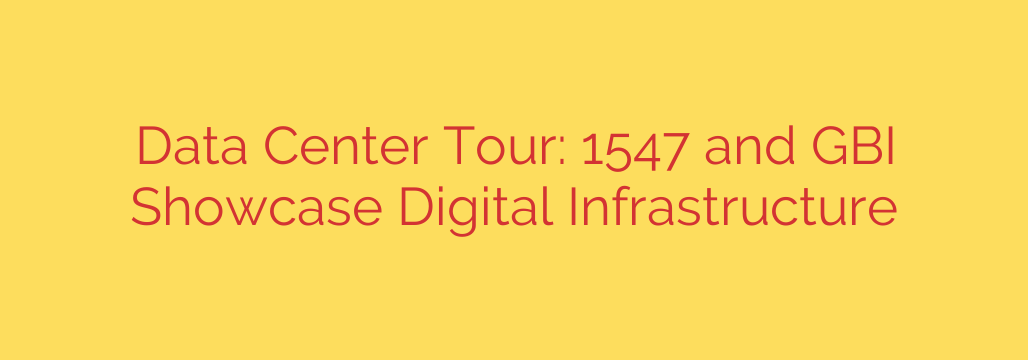
The Heart of the Internet: A Deep Dive into Modern Data Center Infrastructure
Every time you stream a movie, access a cloud file, or join a video conference, you are connecting to a data center. These facilities are the invisible backbone of our digital world, housing the critical computing and networking equipment that powers modern life. But what exactly goes on inside these secure, complex buildings?
A truly effective data center is more than just a fortified warehouse with servers. It’s a sophisticated ecosystem where physical infrastructure and global connectivity converge. Understanding this convergence is key to appreciating how our data travels securely and instantly across the globe.
Let’s explore the essential components that make up a state-of-the-art data center.
More Than a Building: The Data Center Ecosystem
Think of a data center not as a single entity, but as a bustling digital marketplace. The most valuable facilities are carrier-neutral, meaning they provide access to a wide variety of telecommunication and network service providers. This creates a competitive and resilient environment.
This ecosystem approach allows customers—from small businesses to global enterprises—to connect with the partners, cloud providers, and networks they need under one roof. It’s this rich digital infrastructure that transforms a building into a strategic hub for business operations.
The Three Pillars of Data Center Infrastructure
At its core, a data center’s reliability rests on three physical pillars: power, cooling, and security. Failure in any one of these areas can lead to catastrophic downtime.
1. Power: The Lifeblood of Digital Operations
Consistent, clean power is non-negotiable. Data centers draw massive amounts of electricity from the utility grid, but they never rely on it alone.
- Redundancy is Everything: A critical concept is redundancy, often described as N+1 or 2N. This means having at least one independent backup for every component (N). A 2N architecture provides two independent power systems, offering complete fault tolerance.
- Uninterruptible Power Supplies (UPS): These massive battery systems provide instant, temporary power the moment an outage is detected. This gives the facility’s backup generators the crucial seconds they need to start up and take over the load.
- Backup Generators: Fueled by diesel and often holding enough fuel to run for 24-72 hours or more, these generators ensure the facility can operate “off-grid” for extended periods during a major power failure.
2. Cooling: Preventing a Digital Meltdown
Servers and networking equipment generate an immense amount of heat. Without sophisticated climate control, a data hall would quickly overheat, causing equipment to fail.
Data centers use industrial-scale cooling systems, including computer room air conditioner (CRAC) units and chillers. Modern designs often employ hot aisle/cold aisle containment, a strategy that separates the cold air intake for servers from their hot air exhaust. This dramatically improves cooling efficiency and reduces energy consumption.
3. Security: A Fortress for Your Data
Data is one of the most valuable assets in the world, and data centers protect it with layers of stringent physical security. Access is granted on a need-to-be-there basis and is heavily controlled through:
- Perimeter Security: High fencing, vehicle barriers, and comprehensive video surveillance create the first line of defense.
- Multi-Factor Access Control: Entry typically requires passing through multiple checkpoints, often including key cards, PIN codes, and biometric scanners (like fingerprint or iris readers).
- Mantraps: These are small, secure vestibules with two doors that can never be opened simultaneously. They trap an individual between secure points, ensuring only one authorized person can enter at a time.
- 24/7/365 Monitoring: A dedicated security team monitors the entire facility around the clock, ready to respond to any alert instantly.
Connectivity: The Global Information Superhighway
While robust infrastructure keeps the lights on, connectivity is what gives a data center its purpose. This is where data enters and leaves the facility, connecting it to the rest of the world.
The nerve center for this activity is the Meet-Me Room (MMR). This is a secure space where dozens or even hundreds of network carriers bring in their fiber optic cables to interconnect with each other and with the data center’s customers.
A facility with diverse connectivity from numerous providers offers significant advantages:
- Resilience: If one carrier has an outage, traffic can be rerouted through another, preventing service disruption.
- Low Latency: Direct connections to major network backbones, including subsea fiber optic cables that link continents, ensure data travels the fastest and most efficient path possible.
- Flexibility: Customers can choose the best provider for their specific needs, whether for cost, performance, or geographic reach.
What This Means for Your Business Security
When evaluating a data center for your own needs, it’s essential to look beyond just square footage and cost.
- Ask About the Ecosystem: Inquire about the number and type of carriers in their Meet-Me Room. A rich and diverse ecosystem is a sign of a high-value facility.
- Verify Redundancy Claims: Don’t just accept “N+1” at face value. Ask for details about their power and cooling architecture to understand their true level of fault tolerance.
- Tour the Facility (If Possible): Witnessing the security protocols, the cleanliness of the data halls, and the scale of the power and cooling infrastructure firsthand provides confidence that a provider can protect your critical assets.
Ultimately, a modern data center is a marvel of engineering and logistics, built to provide the secure, resilient, and highly connected foundation our digital economy depends on.
Source: https://datacenterpost.com/opening-the-doors-to-digital-infrastructure-an-exclusive-data-center-tour-with-1547-and-gbi/








